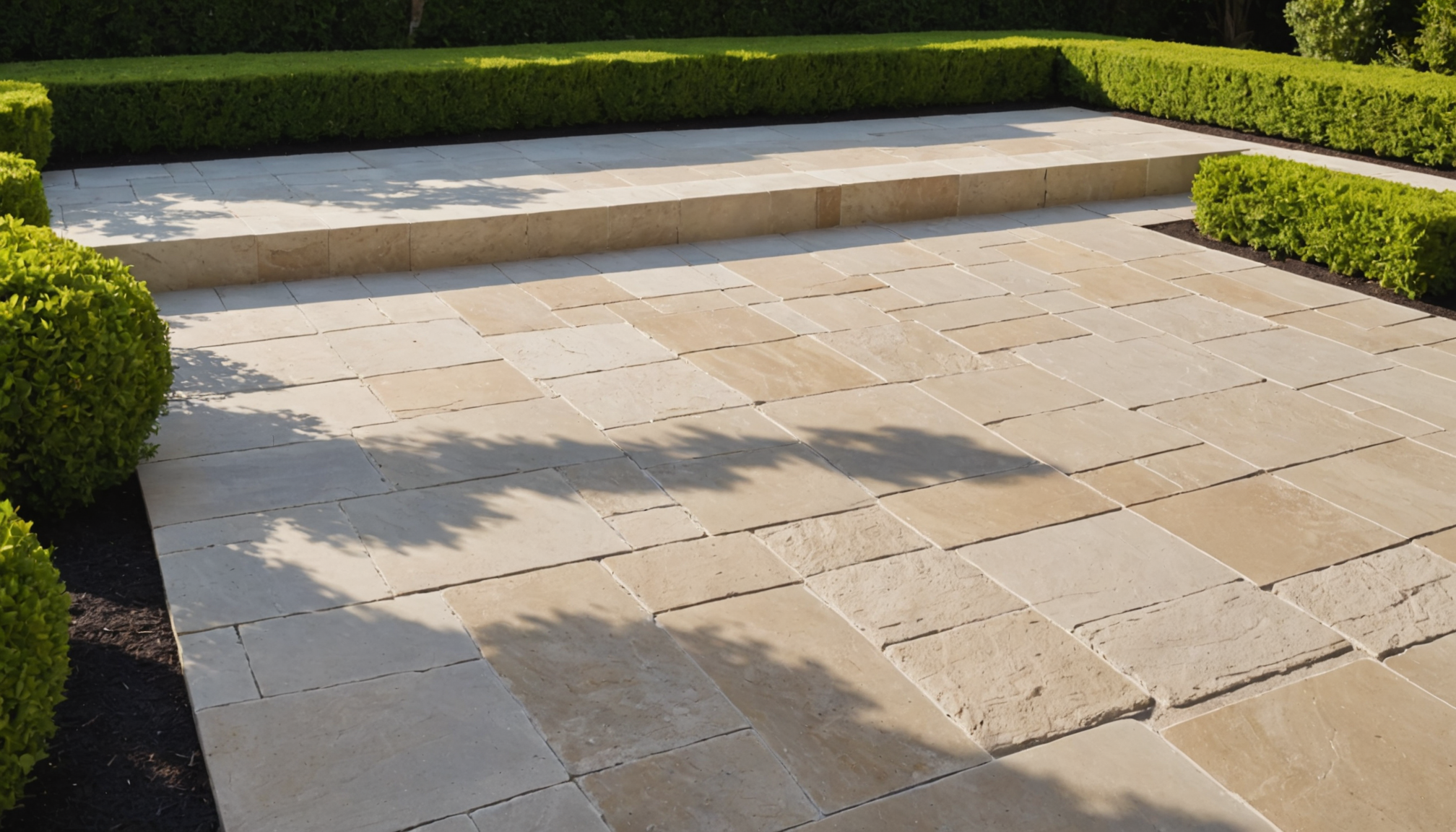When it comes to creating an inviting and enduring outdoor space, selecting the right materials for your patio is crucial. Not only do durable materials bear the brunt of the elements, but they also contribute significantly to the safety and longevity of your outdoor environment. As trends evolve, more homeowners are recognizing the value of investing in materials that offer both aesthetic appeal and robustness.
A primary consideration in choosing patio materials is their ability to withstand various weather conditions while maintaining their integrity and appearance over time. Popular materials such as concrete, natural stone, and composite decking each bring unique benefits to the table. Understanding these can help you make an informed decision that aligns with your style preferences and durability needs.
Concrete remains a popular choice due to its strength and versatility. It can be poured in virtually any shape and tinted or stamped for design flexibility. Despite its resilience, untreated concrete may crack under extreme temperatures, so it is often treated or sealed to enhance its durability.
Natural stone, such as granite, slate, or travertine, provides an elegant look and can seamlessly blend with the landscape. While these stones are naturally durable, their porosity varies, making proper sealing essential to protect them from harsh weather and spills. Stone is known for its long-lasting beauty even though it tends to be on the higher end of the cost spectrum.
Composite decking has emerged as a trendy alternative, combining plastic and wood fibers to create a material that is highly resistant to rot and insects. Its low maintenance requirements make it particularly appealing for busy homeowners. However, not all composites are made alike, so comparing the pros and cons of different brands and products is worthwhile.
| Material | Advantages | Disadvantages |
| Concrete | Strong, Versatile, Cost-effective | Can crack, Requires sealing |
| Natural Stone | Elegant look, Durable | Higher cost, Porous |
| Composite Decking | Low maintenance, Resistant to rot | Variable quality, Higher upfront cost |
Beyond durability, safety should also be a key factor in your decision-making. Non-slip surfaces help to prevent accidents, especially in wet conditions. Choosing materials with texture or finishes designed to enhance grip can protect your friends and family while enjoying the patio.
With the insights above, aligning your material choices with optimal safety and style considerations ensures that your patio can withstand the test of time and provide a beautiful and functional outdoor space. Therefore, focus on these aspects to strike the perfect balance between enduring aesthetics and practical usability in your material choices.
weatherproofing techniques
Weatherproofing your patio is an essential step to ensure its longevity and maintain its appearance despite the changing seasons. While choosing the right materials sets a strong foundation, applying effective weatherproofing techniques provides an additional layer of protection. Follow these step-by-step guidelines to keep your outdoor space in tiptop condition:
1. Seal Your Surfaces:
– Identify the materials used in your patio, such as wood, concrete, or natural stone, and select a compatible sealant.
– Clean the surfaces thoroughly to remove dirt, mildew, and any old sealant residue. This ensures the new sealant adheres properly.
– Apply the sealant evenly using a brush, roller, or sprayer, starting from one corner and working your way across the entire surface. Pay special attention to seams and edges.
– Allow the sealant to cure as per the manufacturer’s instructions, typically ranging from 24 to 48 hours.
2. Use Water Repellent Treatments:
– Choose a water repellent product that is suitable for the specific material of your patio.
– Before application, check the weather forecast to ensure a clear, dry day since water repellents need time to set without interference from rain.
– Apply the water repellent evenly, ensuring you reach all areas, including less visible spots like corners and undersides.
3. Install Protective Covers or Awnings:
– Consider adding a retractable awning or durable patio cover designed to shield your outdoor space from direct sun, rain, and snow.
– Measure your patio area and select a cover or awning that provides sufficient coverage while complementing the aesthetic of your home.
– Follow the installation instructions carefully or hire a professional to ensure stability and safety.
4. Apply Rust-Prevention Products to Furniture:
– For metal furniture, use a rust-prevention spray or coating specifically designed for outdoor use. This will help protect it from moisture and prolong its life.
– Clean and dry your furniture thoroughly before application to maximize adherence and effectiveness.
– Reapply annually, or as indicated on the product for optimal protection.
5. Enhance Drainage:
– Ensure your patio has adequate drainage to prevent water pooling, which could lead to structural damage over time.
– If necessary, consider installing drainage systems such as French drains or adding more slope to allow water to flow away from the patio.
– Regularly clear debris from drainage channels to maintain efficiency.
6. Protect Fabric and Upholstery:
– Use outdoor furniture covers made from water-resistant materials during the off-season or heavy rain periods.
– Treat cushions and fabric accessories with a fabric protector spray to guard them against moisture and UV damage.
– During inclement weather, store portable fabric items indoors to extend their lifespan.
Weatherproofing not only helps protect your investment but also ensures your patio remains a comfortable and attractive space for relaxation and entertainment. These techniques are vital in adapting to current trends that emphasize the blend of functionality, comfort, and aesthetics in outdoor living spaces.
maintaining your furniture
Keeping furniture in optimal condition is crucial for maintaining the overall appeal and functionality of your patio space. While selecting the right materials and employing weatherproofing techniques lay the groundwork for a resilient outdoor area, devoting regular attention to your furniture ensures a longer-lasting and more visually pleasing arrangement. Begin this process by meticulously cleaning your furniture. Dirt, grime, and organic material, if left unchecked, can damage both the structure and appearance over time, especially in areas with harsh weather patterns. A non-abrasive cleaner tailored to the specific material—be it wood, metal, or plastic—will help in removing buildups without causing harm.
Regularly inspecting your patio furniture is another essential step. Look for signs of wear, such as rust on metal pieces, splintering wood, or fraying fabric, and address these issues swiftly to prevent them from escalating. For metal furniture, apply a fresh coat of rust-resistant spray when needed. Wooden furniture can benefit from a fresh finish or sealant every few years, which not only revitalizes the appearance but also acts as a protective barrier against environmental damage.
Incorporating cushion storage solutions can also play a pivotal role in safeguarding your furniture. Throughout weather changes or during periods of non-use, storing cushions in a dry, shaded area prevents mold growth and fabric deterioration, ensuring they’re always ready to provide comfort during your next outdoor gathering. Additionally, regularly fluffing cushions after use helps maintain their shape and resilience, contributing to both aesthetic appeal and comfort.
Apart from the structural care and maintenance of your furniture, staying updated with the latest trends can dramatically enhance your outdoor living space. New furniture designs often incorporate materials and coatings engineered for durability and ease of maintenance. Updating your patio with these innovative pieces can amplify both style and functionality, making it a long-term investment in your home’s appeal.
In keeping with safety, ensure all furniture is stable and well-secured, eliminating the risk of tipping or collapse, especially during periods of strong winds. For pieces like tables and benches, periodic tightening of screws and joints can mitigate potential accidents, allowing you, your family, and guests to enjoy the space without concern.
Ultimately, maintaining your furniture is about aligning longevity with aesthetics and functionality. By dedicating time to inspections, cleaning routines, and periodic updates, you protect your investment and foster an inviting atmosphere that beckons relaxation and enjoyment throughout the years to come.
enhancing outdoor comfort
Creating a comfortable and cozy environment on your patio is key to making the most of your outdoor living space. It’s about more than just having a set of tables and chairs; it’s about crafting an inviting area that beckons relaxation and enjoyment. This involves a combination of strategic planning, choosing the right accessories, and incorporating elements that cater to both comfort and style.
First, consider the seating options available. Plush outdoor cushions and pillows can go a long way in elevating the comfort level of any seating arrangement. Look for cushions that are both water and UV-resistant to protect them from the elements, ensuring longevity and sustained comfort. Regularly updating these textiles not only helps maintain comfort but also allows you to incorporate the latest trends, giving your patio a fresh and modern look without a complete overhaul.
Another critical aspect of outdoor comfort is climate control. Depending on your local climate, this might mean adding elements to either warm up or cool down your space. For colder climates or chilly evenings, consider installing outdoor heaters or a stylish fire pit. These additions not only generate warmth but also create a cozy and inviting ambiance. In contrast, for hot summer months, incorporating patio umbrellas or shade sails can provide much-needed relief from the sun, allowing you to enjoy your space comfortably at all hours.
Lighting also plays a crucial role in enhancing outdoor comfort. Strategically placed lighting can transform your patio into a welcoming retreat once the sun goes down. From string lights draped overhead to solar-powered garden lamps illuminating pathways, the right lighting can set the mood and ensure safety as guests move about the space. Solar lights are not only energy-efficient but also require minimal effort to install, making them a popular choice among homeowners looking to keep up with eco-friendly trends.
In terms of aesthetics, consider the addition of decorative elements such as outdoor rugs, which not only tie together the design of your patio but also add an extra layer of comfort underfoot. Water-resistant rugs are particularly advantageous as they withstand rain and spills, keeping maintenance to a minimum.
Incorporating greenery is yet another way to enhance outdoor comfort. Potted plants and vertical gardens not only beautify the space but also provide a sense of serenity and connection to nature. Selecting low-maintenance plants that thrive in your climate can reduce the effort needed to maintain them.
Finally, remember the importance of privacy in creating a comfortable outdoor area. Consider using trellises with climbing plants or installing outdoor screens to create a secluded atmosphere while still enjoying the openness of your patio. These solutions not only offer privacy but also add an element of style and sophistication.
By focusing on these elements, you ensure your patio remains a welcoming and comfortable space throughout the year, adapting to both seasonal changes and personal style preferences. Whether you’re hosting a gathering or seeking a peaceful place to unwind, a well-planned and equipped patio can provide all the comfort and functionality needed to make the most of your outdoor living area.
seasonal care tips
As the seasons change, so too do the demands on your patio maintenance routine. To keep your outdoor area in prime condition throughout the year, it’s essential to tailor your care efforts to each season’s unique challenges. By doing so, you not only protect your investment but also ensure your patio remains a safe and inviting haven for relaxation and entertainment.
During spring, focus on revitalizing your patio after winter’s hibernation. Start by cleaning your surfaces thoroughly to remove any debris and sediment left behind by melting snow or rain. It’s a good time to reseal or restain wooden surfaces that may have been exposed to harsh weather conditions, ensuring they’re prepared to withstand the coming year. Spring is also ideal for checking the condition of your plumbing related to outdoor kitchens or water features to guarantee everything is in working order before heavy use during the summer months.
As summer arrives, it’s crucial to manage the increased exposure to sun and heat. Adjust your patio’s arrangements to maximize shade without sacrificing aesthetic appeal. Consider applying UV-protectant sprays to fabrics and cushions to prevent fading. Switching out your patio’s decor to lighter, breathable fabrics can help maintain comfort and reflect current design trends. Ensure that your patio structures, such as awnings and umbrellas, are securely anchored to withstand any unexpected summer storms.
Once autumn rolls around, falling leaves and fluctuating temperatures signal a time to prepare your patio for winter dormancy. Regularly sweep away leaves, as they can lead to staining if left damp on surfaces. Draining and winterizing any plumbing outdoors, like fountains or faucets, can prevent damage caused by freezing. During this season, store cushions and non-weatherproof furniture inside to extend their life, and consider adding protective covers to your patio set to shield it from the elements.
Winter requires specific attention to snow and ice management. Keeping pathways clear is crucial for safety, so invest in durable brooms or snow shovels that won’t damage your patio materials. Avoid using harsh chemical ice-melts that can deteriorate surfaces over time. Instead, opt for pet-friendly and material-safe deicing options. This season is also a smart time to evaluate any needed repairs or refurbishments that can be tackled during downtime, ensuring your patio is ready to shine come spring.
Staying attuned to seasonal maintenance needs not only fosters a long-lasting and beautiful patio space, but also supports its functionality and safety year-round. By implementing these care strategies, you can confidently enjoy your outdoor retreat no matter the season, ensuring it remains ready to provide year-round enjoyment and relaxation.


